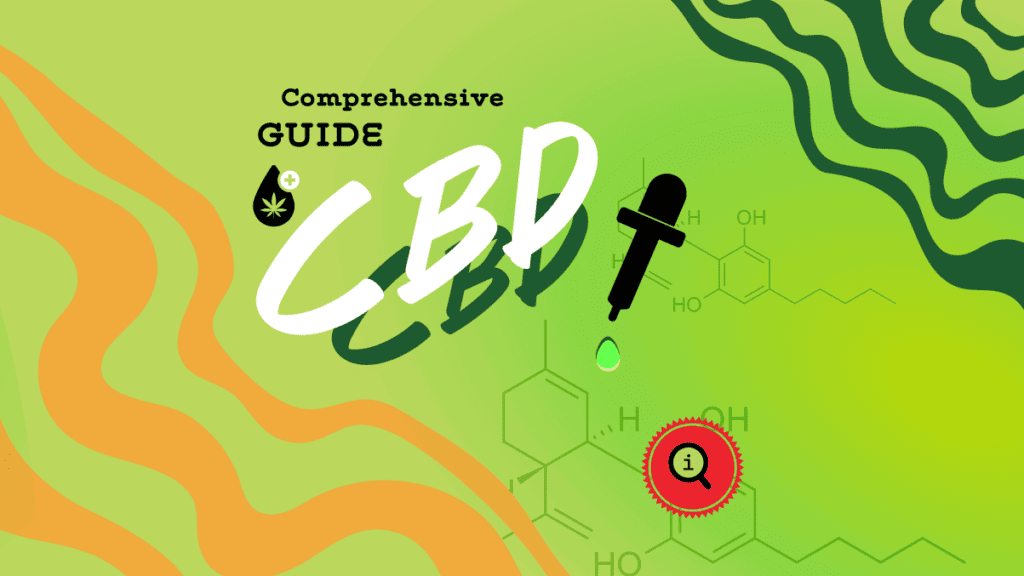- Dispensaries
-
Cultivars
By Cultivar Types
By Effects
By Terpenes
- Blog & Press
- About
- Products
CBD (Cannabidiol): Understanding How It Works, Benefits, Side Effects And More
- Cenk Cetin
- January 16, 2024
- 1:42 pm
- No Comments

Introduction
Cannabidiol, or CBD is a non-psychoactive compound present in cannabis. Due to its mild effects on the consciousness of the consumer, isolated CBD has been a regulated part of the wellness industry for a significant time longer than other parts of the plant. This officially recognised safety and effectiveness paved the way for a wide range of products to come on the market. From topical skin creams, wellness and sleep health tinctures and gummies and pet therapy. CBD is one of if not the fastest growing wellness industry in the world. There is a growing reputation of the effects of CBD on the body as more research and evidence comes out in support of CBD. It seems to help with things such as inflammation, chronic pain, anxiety and even seizures. This is raising more implications about the body’s overall connection with the endocannabinoid system (ECS) and how important understanding it is for not only our individual health, but also our collective, public mental and physical health. This article will look at the story of CBD, its possible uses and the role it plays in the modern wellness and medicine scene.
Understanding CBD
CBD and THC are the most well known cannabinoids. There are actually dozens of defined cannabinoids in cannabis as well as several hundred terpenes found in cannabis. Research is still ongoing and we are learning more with each year. Each new nation embracing legalization brings us further along the journey.
With medical uses in Asia tracing back to at least 3000 BC, cannabis has been criminalized for the tiniest part of its history, yet this prohibition has managed to see thousands suffer from jail sentences, violence due to organized crime and of course, sub optimal product as a result of an unregulated market not facilitating the proper medicinal and cultural research and practices.
CBD has been formally legalized in more countries than THC so it has benefited from more scientific studies and more official customer feedback when compared with studies on THC alone. You could say that CBD is the bridge between prohibition and proper research and development of cannabis products. Now there is a vast array of information online for consumers to conduct their own research, even if there still is work to do on the pharmaceutical research side of things.
CBD was first isolated in 1940 by american chemist Roger Adams at Illinois university. In the 1980’s, Israeli Chemist Rapheal Mechoulam was the first to reveal the structure of THC and CBD and noticed CBD’s potential help with seizures among other ailments. However, as the ‘war on drugs’ had begun in the early 70’s, this research wasn’t officially implemented in global science so those who could have benefited were denied potentially life changing medicine for decades to come.
How CBD Works in the Body
CBD and THC are more specifically phytocannabinoids, “phyto” meaning “plant” in Greek, meaning these compounds are found in plants. An Endocannabinoid on the other hand, is a compound produced by our own body, “endo” being the Greek word for “inner” or “containing”. This terminology comes from the fact that phytocannabinoids, uniquely found in cannabis, interact with the Endocannabinoid System or ECS as a whole. THC has a molecular structure so similar to our hormone responsible for bliss, it can mimic the effects caused by the naturally produced endocannabinoid. While CBD inhibits the breakdown of our endocannabinoids as well as modulating the balance of the THC we put in our body.
The ECS was discovered in 1992 by Raphael Mechoulam but was left out of medical textbooks despite the mounting evidence for its massive relevance in medicine. In fact, the ECS is an extremely influential system in the body which actually in many ways governs other important systems, like the immune or cardiovascular system, because the ECS is built to regulate both mood and ‘homeostasis’ in the body. Homeostasis is the term used to describe the self regulating process of any organism to balance their internal functions with their external environment. It turns out that the ECS is a 600 million year old system present in all animals except insects to regulate homeostasis in the body. This is done in humans through two distinct systems of cannabinoid receptors labeled CB1 and CB2, targeting different groups of other systems in the body. Shown and in the picture below, we can see how many things, and how much of our lives, rely on from homeostasis to function.
Anandamide is the ‘bliss’ molecule that when it binds to the cannabinoid receptors in the brain we feel a sense of calm and happiness. Anandamide can also be found in chocolate, and is also the hormone that is responsible for the runners high. Naturally produced bliss hormone anandamide is actually broken down by an enzyme called Fatty Acid Amide Hydrolase, or FAAH. The interesting thing is that CBD actually inhibits the action of FAAH, meaning it allows the body to experience its naturally occurring anandamide for longer. This function is what increases and stabilizes mood and reduces anxiety and stress. This is also the desired function of many pharmaceutical drugs that treat anxiety and depression. CBD is increasingly showing better results than these drugs and with very minimal side effects.
Common Health Conditions and Ailments
The health benefits of CBD are seemingly endless as more research is being done for more discoveries are being made since we are only a few decades into properly researching these compounds. There is, however, a vast amount of benefits that we have already learned about. From simple reduction of swelling or soreness of skin to treating Parkinson’s disease, CBD once properly globally regulated could have profound effects on international public health. There are a wide range of physical and mental ailments and conditions that CBD has already proven to help. Below is a loose outline of conditions CBD products can treat.
Skin Care
Topical skin creams and balms with CBD can treat conditions such as eczema or psoriasis as well as a simple bruise or insect bites. The products utilize the ECS’s connection to the immune system as CBD can help calm the immune system down and thus reduce inflammation or swelling to treat chronic or acute pain. Some creams are also specially formulated for cosmetic skin care as the antiinflammatory properties also work well in the beauty industry, for example anti-aging creams. Using these creams to treat physical problems could also have the side effect of regulating your mood as well.
Neurological Conditions
CBD, and other cannabinoids, have been shown to also help treat some physiological disorders like Alzheimer’s Disease and Parkinson’s disease and epilepsy. The results, particularly for epilepsy have proven solid enough for the FDA in America to approve a CBD based epilepsy drug that has less side effects than the pharmaceutical competitor.
Insomnia
CBD can help people with chronic pain, anxiety or general insomnia to fall asleep because their body is generally more regulated and calmer. A good night’s sleep is a highly important part of human general well being. People who struggle with sleep do get differing results with CBD as it is not exactly a sedative. Better results on this practice are often seen over time with the person taking CBD often twice a day.
Anxiety and Stress
Anxiety and stress are some of the most prevalent and under treated mental health conditions on the planet. CBD is widely known for its effectiveness in treating anxiety and various anxiety related psychological disorders like PTSD. Again there has only been limited studies on this but small studies show improvements in PTSD over time using CBD.
High levels of stress in the body can have physiological and physical implications. CBD’s ability to inhibit the enzyme that reduces the natural bliss hormone is the key to its stress relieving effect. Our bodies have more balanced positive chemicals to work with and therefore we feel holistically less stressed.
Possible Side Effects
Important to note that for a minority of people there will be some side effects such as nausea, fatigue and fever. Like any medication, zero side effects for 100% of the patients is almost impossible. Luckily the side effects of CBD are mostly minor and fairly easily recognised. If you experience these symptoms it may be the case that your metabolism does not work well with CBD. It’s therefore in your best interest to stop using the product and see if the unwanted effects go away.
What doctors say about CBD:
Choosing, Using and Transporting CBD Products
CBD, as previously mentioned, comes in a variety of forms. The most common forms found in the Thai industry are oils or tinctures, balms, gummies and beverages. The oils and tinctures are usually for self medicating, usually daily as a part of your self care routine. These formulas are often tailored to a specific ailment like insomnia or epilepsy. Balms and massage oils can be very good for the skin and promote holistic and informed self care. The beverages and gummies appeal to the general well being angle of CBD, they are tasty and refreshing but also can reduce your stress levels and get you closer to the body’s ideal homeostasis.
I think it is important for consumers to build confidence in their own understanding of not only current science but also their unique physical and psychological needs. The more you do this, the more you will be able to improve your quality of life on your own terms.
CBD is fast becoming a normal thing in the average person’s collection of wellness products. Despite widespread global acceptance, there are still several countries that are yet to conclude CBD is a beneficial compound to public health. When in Thailand it is important to note that most of the surrounding countries still prohibit CBD, e.g. China and Indonesia, so it is highly recommended to do the research on what you can bring to what country before you travel.
Conclusion
CBD has a huge potential to continue to benefit a lot of people around the world for serious and less serious conditions. From general well-being to treating seizures, CBD has a significant place in modern medicine and culture. Our endocannabinoid system shows us that we can achieve homeostasis through the conscious use of cannabinoids. Despite being prohibited for some decades, this plant extract that clearly has many uses is now spreading across the planet sharing its gifts.
Like anything wellness, we must do our own research and our own tests on how we respond to different medicines for different conditions. We must learn as much as we can to make sure we are achieving the best health we can. More studies will be conducted on CBD and the other cannabinoids as there is still limited concrete data, so who knows maybe there are even more benefits we don’t even know about!



